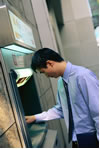Costs in Japan
For an overview of what is paid for by the Nakatani RIES Fellowship or Nakatani Foundation directly please see Program Funding.
Upon arrival in Japan, all Nakatani RIES Fellows will receive a meal/living stipend in Japanese yen that is equivalent to about 1,500 JPY per day (~$14 USD/day at current exchange rate). This meal/living stipend is to be used to purchase lunches and dinner during the three-week orientation in Tokyo, for all meals during the research internship period, for daily commuting/transportation costs via subway or bus during the orientation program and research internship period, and other required/necessary expenses.
There will be three disbursements of the total meal/living stipend provided. The first will be on the Monday after arriving in Tokyo, the second will be on the day the students leave Tokyo for their research host labs, and the final disbursement will be at the end of the Mid-Program Meeting. Students will need to carefully budget these funds throughout the summer. If you spend more than the meal/living cost stipend provided, you will need to use personal funds to pay for these expenses.
Students must use personal funds to pay for all cell phone rental and usage charges, independent sight-seeing, souvenirs, shopping, and other personal expenses and for any costs incurred above and beyond the meal/living cost stipend provided.
Money in Japan
 The currency in Japan is called the Yen and, unlike the U.S., Japan is still a highly cash-based society. While it may feel odd to carry lots of cash with you, especially for Americans who primarily rely on debit and credit cards, cash is truly the easiest means of payment in almost all situations in Japan. It is more likely that you will misplace your money in Japan than have it stolen or pick-pocketed – though this is still possible so students should take reasonable precautions and keep cash in a safe place at all times.
The currency in Japan is called the Yen and, unlike the U.S., Japan is still a highly cash-based society. While it may feel odd to carry lots of cash with you, especially for Americans who primarily rely on debit and credit cards, cash is truly the easiest means of payment in almost all situations in Japan. It is more likely that you will misplace your money in Japan than have it stolen or pick-pocketed – though this is still possible so students should take reasonable precautions and keep cash in a safe place at all times.
Nakatani RIES recommends students bring at least $1,000 to $1,500 in cash with them to Japan and exchange all of this upon arrival at the airport in Japan where you will get the best exchange rate. We do not recommend exchanging your U.S. dollars into Japanese Yen prior to departure as the exchange rate you will get in the U.S. will likely be much lower than what is available at the airport upon arrival in Japan.
XE.com Currency Converter
With over 18 million monthly users, XE is the trusted choice for the latest currency rates and information. Access free live rates, currency tools, and market analysis using the most accurate data.
Withdrawing Money from International ATMs in Japan: Most ATMs in Japan, including those at most banks, do not accept credit, debit and ATM cards issued outside of Japan. To withdraw funds in Japanese Yen from your U.S. accounts you will need to use an international ATM. The most convenient place to find an international ATM is at any 7-11 Convenience Store which are open 24 hours a day 7 days a week. You can also access international ATMs at any Japanese Post Office, though some post offices close as early as 4:00 PM and they may not be open at all on the weekends. International ATMs can also be found at airports, in some department stores, and at Citibank locations throughout Japan. Be sure you are aware of the daily withdrawal limit and international withdrawal and currency conversion fees your bank will charge for accessing your account from a Japanese ATM. You may need to plan out your withdrawals over the course of a few days for large purchases that need to be paid in cash such as housing fees during the research internship period as most university dormitories or guesthouses do not accept payment via debit/credit card.
Credit Cards in Japan: International credit cards can be used at most major department stores, stores catering to tourists, most mid-range to high-end hotels, and, in some cases, can also be used to purchase train tickets. However, you should be aware of the international transaction and currency conversion fee your card charges and factor this into the price. Most students find it more convenient and a safer bet to pay in cash. Most small shops, grocery stores, inexpensive restaurants, cabs, etc. will only accept payment in cash.
Traveler’s Checks: You can also choose to bring your money with you in the form of Traveler’s Checks but be aware that these can only be exchanged at the airport or at banks displaying an AUTHORIZED FOREIGN EXCHANGE sign. Foreign exchange hours at most banks are limited and it can take a long time to complete your transaction. It is generally more convenient to bring your initial funds in cash and then plan to withdraw funds in Japanese Yen from an ATM for the duration of the summer.
See also Food in Japan and Housing in Japan.
Japan Budget Travel Guide – how to save money on a trip to Japan
